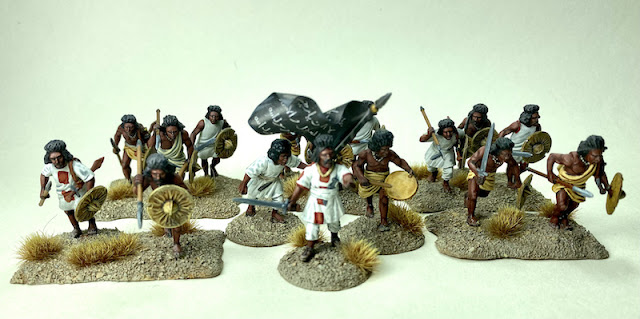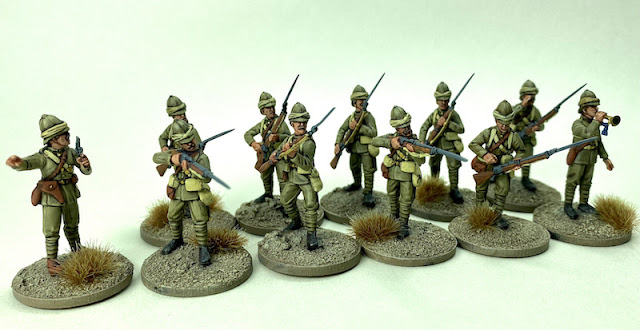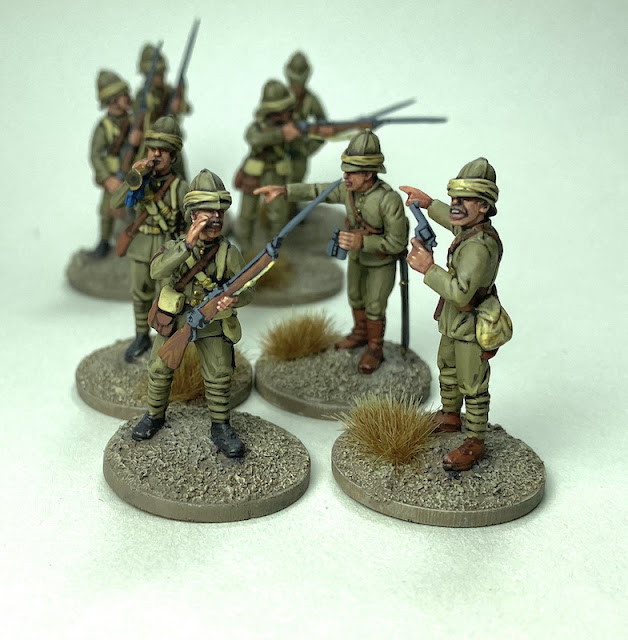The one upside to an unexpected and prolonged lockdown has been the revival of my Colonial era project. Despite letting a month pass without posting anything new on the blog it's not because I haven't been busy painting.
The first forty Perry 28mm plastic Mahdist Ansars are now completed and I have the figures from a second box assembled and based awaiting primer. To oppose them I have a box of Perry British Infantry, some of which I started way back in April 2020. This is a fairly versatile box set that can be used for a number of campaigns beyond the Sudan, including the North West Frontier and Afghanistan.

I like the idea of playing large skirmish games with these and I have a copy of Daniel Mersey's
The Men Who Would Be Kings (TMWWBK) which are ideally suited to the period. I would dearly love to see Too Fat Lardies' black powder rules
Sharp Practice expanded to include this period and have been following John Savage on Twitter and Facebook, as he has been testing a variant for the Sudan that may see publication in the forthcoming Lard Magazine.
Most skirmish rules involve individual basing, which works fine for me as I'm happy to use sabot bases to help move groups of figures. That's ideal for more regular or drilled units but doesn't quite look right for tribal groups or irregulars. I know there are sabot bases available where figures are spaced in a more irregular pattern but I quite like the idea of basing in 3s, 2s and 1s. This would give tribal units a less rigid appearance while allowing for ease of movement and the removal of casualties. So that's been my approach.
The bases are cut from larger pieces of 2mm MDF. The edges are beveled to give them a more natural appearance using the sanding tool on a Dremel.
As for painting the figures I thought this might be a good opportunity to try the Citadel contrast paints for the fabrics. I primed the clothing in either white or dark sand. With the white I used the contrast paint Apothecary White and with the dark sand Skeleton Horde. The results were very pleasing and I can foresee a number of other applications where the contrasts will work well. The figures did receive a final highlight with a paintbrush, but overall I achieved the effect I was after very quickly.
A group of Tribal Infantry in TMWWBK is made up of sixteen figures including a leader. Sharp Practice tends to have smaller size groups and I'd expect Tribal Infantry to be in groups of approximately twelves. Either way the 3,2,1 basing system would work for either. So for TMWWBK I'm looking at a group of sixteen being made up of three bases of 3 figures, two bases of 2 figures and three bases with a single figure.
The Perry figures are very versatile and allow for a good variation in poses or weapons. That's allowed me to keep the units looking less regimented. Here are some of the three figures bases:
The two figure bases are simply a variation of the three figure bases, but with one less figure:
Individually based figures include those that might need to be differentiated in one way or another depending on the rule set, such as leaders, musicians or flag bearers, but they also include individual warriors.
The Perry box sets come with a very useful information sheet that includes a number of flags and banners. They are printed on glossy paper and so I copied them and reprinted with an inkjet onto normal copy paper. This made them easier to soften with PVA glue to shape them.
The sets come with a number of arms with rifles and so I have based all of these riflemen individually. They can be mixed in with the larger groups or made up into groups of skirmishers or other rifle armed groups.
This is the first time I've painted darker flesh colours on a large number of figures, so it took me a few trial attempts to settle on colours that worked for me. Originally I used a base colour of Vallejo Game Colour Dark Fleshtone with an overall highlight of VGC Tan, further highlighted with a mix of VGC Tan and Army Painter Barbarian Flesh. The end result was a bit lighter than I wanted and you can see that in the picture above with the second rifleman from the left painted in those colours. So I moved to something darker starting with a very dark base colour of Vallejo German camouflage Black Brown. The overall highlight was VGC Dark Fleshtone which was highlighted with a mix of that and VGC Tan. I think that's worked a lot better.
Overall with the basing I've tried to give myself as much flexibility as possible and to future proof the collection so it can be used across several different rule sets if I choose. So far I think they are making for a suitably imposing looking horde of warriors.
I know the 3,2,1 basing system works for others and so I'm hoping I've got the balance right, I guess the real test will come when I can get back to face-to-face gaming. For now though I'm saying it's 3,2,1....all stations go.
Before I start on the next box of Mahdists I've taken a break to paint up some of the British. I like these figures a lot, they are very reminiscent of the poses you might see in Victorian paintings of the period.
As you can see these are based individually and more traditionally on 25mm rounds. I intend creating sabot bases to use with them, probably with four figures in each, as this will allow them to be grouped in eights for Sharp Practice or twelves for TMWWBK.
I haven't used contrast paints with these. The base colour for the uniform is Vallejo Khaki and the webbing is Buff. They were then washed with Citadel's Agrax Earthshade. The uniform was highlighted with Khaki and then a mix of Khaki and Dark Sand.
I've ordered another box of British as the 36 that come in a single box won't give me enough figures for a game. Of course there's no point ordering just one box so I've add a couple of boxes of Afghan Tribesman to the order as these should work for the North West Frontier and Afghanistan. Might as well keep my options open, eh?























Lovely painting Mark, yes its a bit of a challenge painting darker skin tones, not sure how the Sudanese with fair up against the fire power of the Brits.
ReplyDeletecheers John
Thanks John. Historically the Mahdists were not unlike the Zulu, when they could close quickly with the British they could offset the disadvantage in firepower.
DeleteVery nicely done.
ReplyDeleteThanks Norm.
DeleteThese are nice - look forward to some skirmish game AARs soon. Once the collection has grown a bit you should really try out ‘The Sand of Sudan’ rules by your fellow antipodean - the pyjamaed Carlo Pagano (http://withpyjamasthroughthedessert.blogspot.com/). Their predecessor ‘Pony Wars’ have always given me great fun games.
ReplyDeleteThanks Rob, I have visited the blog before but had no idea it was based so close to home.
DeleteThese look truly fantastic Mark. Very well done indeed and those Perry plastics are wonderful sculpts. Rob btw is a very, very clever man😂
ReplyDeleteThanks Carlo, did Rob pay you to say that? 😂
DeleteReally interesting post and looking forward to the Afghans,there was an interesting post on the contrast painting Facebook group as a recipe for dark flesh of magos purple followed by fireslayer flesh which looked good
ReplyDeleteThanks Clive. I found contrast paints really useful and want to explore them more. I’m not convinced they work for flesh but happy to prove myself wrong so will give this a try.
DeleteGreat looking units, should be fun on the table.
ReplyDeleteThanks. Hopefully we are out of lockdown soon and I can get these on the table.
DeleteExcellent work! I think these must be some of the best painted examples of the plastic British set that I've seen. Well done indeed, looking forward to seeing more.
ReplyDeleteThank you, I take that as a big compliment coming from you. I’ve enjoyed painting them, some of the best Perry plastics.
DeleteWonderful job!
ReplyDeleteThanks!
DeleteExcellent..love the basing
ReplyDeleteThanks Jim, I think the basing has worked well to fit the look of a tribal group.
DeleteThey look superb! Yes, a variation of SP2 for the Sudan would be ace
ReplyDeleteCheers
Matt
Love the basing! Do you have the rough measurements for the multibased ones?
ReplyDeleteThanks. I’m not one for measuring, I tend to do things by eye. I placed figures on a larger 150mm x 120mm piece of MDF and then drew the size around the figures and then cut the sheet with a saw. At a guess the three figures are on a base roughly 40-50mm wide and 30-40mm deep.
Delete